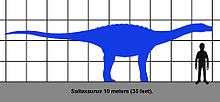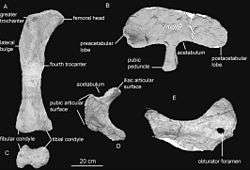Saltasaurinae
| Saltasaurines Temporal range: Late Cretaceous, 80–66 Ma | |
|---|---|
 | |
| Life restoration of Saltasaurus, the type species | |
| Scientific classification | |
| Kingdom: | Animalia |
| Phylum: | Chordata |
| Clade: | Dinosauria |
| Order: | Saurischia |
| Suborder: | †Sauropodomorpha |
| Clade: | †Sauropoda |
| Clade: | †Titanosauria |
| Family: | †Saltasauridae |
| Subfamily: | †Saltasaurinae Powell, 1992 |
| Type species | |
| Saltasaurus loricatus Bonaparte and Powell, 1980 | |
| Genera[1] | |
|
Bonatitan | |
Saltasaurinae is a subfamily of titanosaurian sauropods known from the late Cretaceous period of South America, India and Madagascar. They are considered to be the most derived of all sauropods.
Description

Saltasaurines are relatively small sauropods with the general body shape of a small head, long neck, four limbs, and a long tail. They range from the modest length of Rocasaurus around 8 m (26 ft), to the comparably larger length of 15 m (49 ft) of Neuquensaurus. However, a currently unnamed fragmentary sauropod from Madagascar may turn out to be a saltasaurine longer than Neuquensaurus. The weight of Saltasaurines is very light compared to that of some of the largest dinosaurs. Thomas R. Holtz Jr. found the genera range from around 7,000 to 21,000 kg (15,000 to 46,000 lb), with Saltasaurus and an unnamed genus on both extremes, respectively.[1]
Saltasaurinae is the only known group of sauropods with armour from almost every species. The most probable reason for the bony studs and plates is that it evolved for defence against theropods like Abelisaurus and Carnotaurus. Saltasaurine armour has led to controversies. In 1929 the paleontologist Friedrich von Huene named the genus Loricosaurus for armour he thought to be from ankylosaurians. These bones were found to have similarities to those later discovered on sauropods like Saltasaurus and Neuquensaurus, and as such, Loricosaurus may be the same as one of the other genera.[1]
Age and distribution
They lived in the late Cretaceous, from the early Campanian to the Maastrichtian (about 80 - 66 million years ago) when they perished along with all other dinosaurs except for birds. Saltasaurus is the only named Saltasaurine that lived later in the Maastrichtian than 68 million years ago. Loricosaurus and Neuquensaurus lived around 71 million years ago and the later surviving Jainosaurus lived around 68 million years ago. An unnamed Saltasaurine from Madagascar would have probably survived later, until the Cretaceous-Paleogene extinction event, around 66 million years ago.[1]
The subfamily Saltasaurinae is known almost completely from the Southern Hemisphere with South American forms. Jainosaurus is the only definite Saltasaurine from outside the Southern Hemisphere and is one of two (the other unnamed) from outside of South America.[1]
Classification
In a 1992 study on Saltasaurus, Jaime Powell named a new subfamily within Titanosauridae (a family now considered invalid). He named this group Saltasaurinae, and found many features uniting the group, of the type genus and Neuquensaurus.[3] This group was later supported and defined by Salgado et al. (1997). They defined the subfamily as "the clade including the most recent common ancestor of Neuquensaurus australis, Saltasaurus loricatus, and all of its descendants". They conducted a phylogeny and found that the subfamily was sister to Alamosaurus and only included Neuquensaurus and Saltasaurus.[4] Paul Sereno defined it in 1998, unaware of Salgado's work and gave it a new definition as a stem clade. His definition was "All saltasaurids more closely related to Saltasaurus than to Opisthocoelicaudia".[5] In 2003 Jeffrey A. Wilson and Paul Upchurch elaborated on this definition to All Saltasauridae more closely related to Saltasaurus loricatus than to Opisthocoelicaudia skaryzinskii.[6]


Below is a cladogram by Poropat and colleagues (2014), finding many genera within Saltasauridae,[2] with the placement of Saltasaurinae after Wilson (2003).[6]
| Somphospondyli |
| ||||||||||||||||||||||||||||||||||||||||||||||||||||||||||||||||||||||||||||||||||||||||||||||||||||||||||||
References
- 1 2 3 4 5 Holtz, Thomas R. Jr. (2011) Dinosaurs: The Most Complete, Up-to-date Encyclopedia for Dinosaur Lovers of All Ages, Winter 2010 Appendix.
- 1 2 3 4 Poropat, S.F.; Upchurch, P.; Mannion, P.D.; Hocknull, S.A.; Kear, B.P.; Sloan, T.; Sinapius, G.H.K.; Elliot, D.A. (2014). "Revision of the sauropod dinosaur Diamantinasaurus matildae Hocknull et al. 2009 from the mid-Cretaceous of Australia: Implications for Gondwanan titanosauriform dispersal". Gondwana Research. doi:10.1016/j.gr.2014.03.014.
- ↑ Powell, J.E. (1992). Sanz, J.L.; Buscalioni, A.D., eds. "Osteologia de Saltasaurus loricatus (Sauropoda - Titanosauridae) del Cretácico Superior del noroeste Argentino" [Osteology of Saltasaurus loricatus (Sauropoda-Titanosauridae) of the Upper Cretaceous of Northwest Argentina] (PDF). Los Dinosaurios y Su Entorno Biotico: Actas del Segundo Curso de Paleontologia in Cuenca: 165–230.
- ↑ Salgado, L.; Coria, R.A.; Calvo, J.O. (1997). "Evolution of titanosaurid sauropods. I: Phylogenetic Analysis based on the post cranial evidence" (PDF). Ameghiniana. 34 (1): 3–32. ISSN 0002-7014.
- ↑ Sereno, P.C. (2005). "Taxon Saltasaurinae". TaxonSearch.
- 1 2 Wilson, J.A.; Upchurch, P. (2003). "A revision of Titanosaurus Lydekker (Dinosauria-Sauropoda), the first dinosaur genus with a "Gondwanan" distribution". Journal of Systematic Palaeontology. 1 (3): 125–160. doi:10.1017/s1477201903001044.